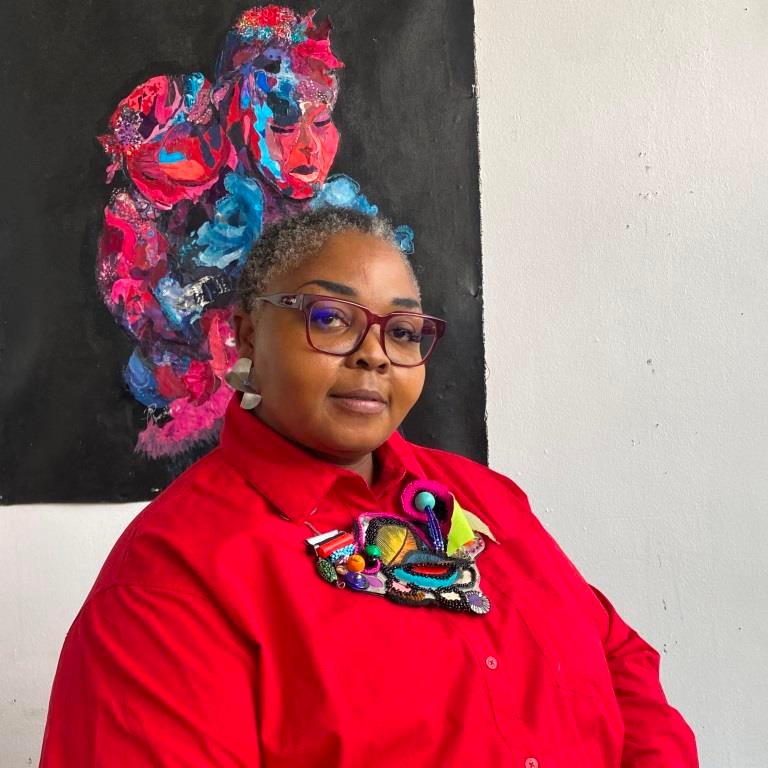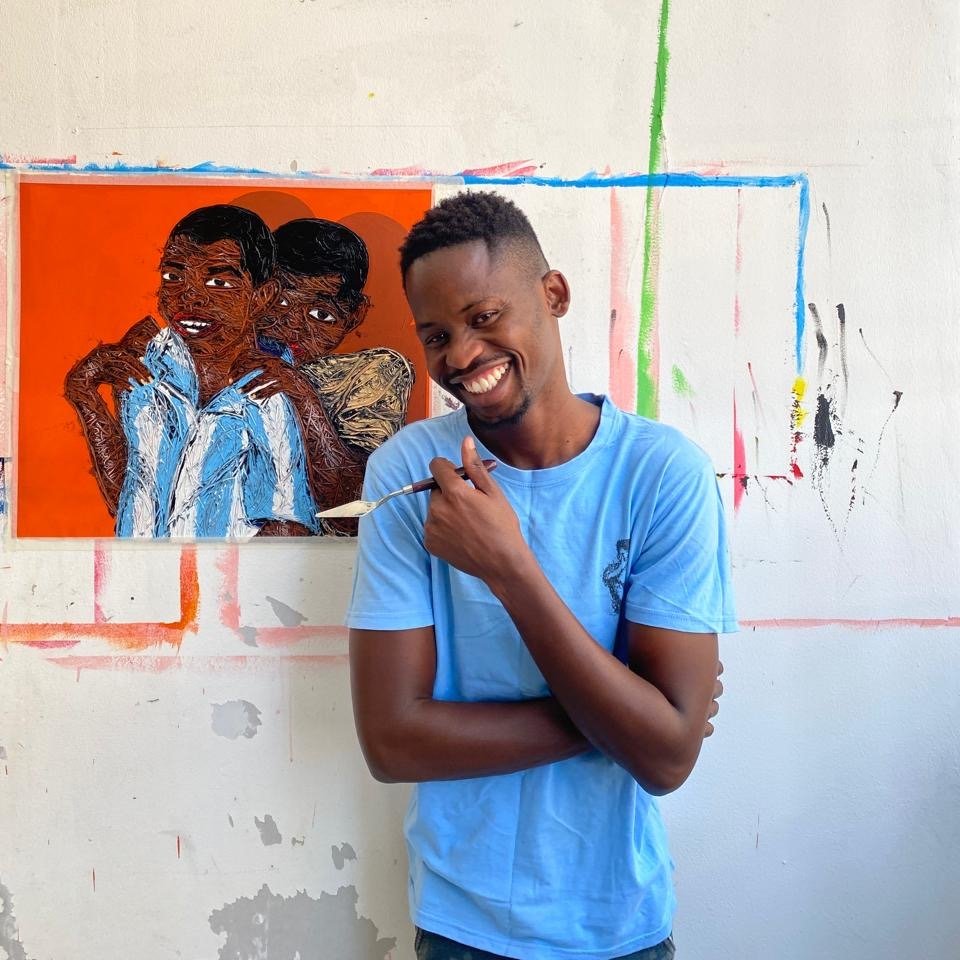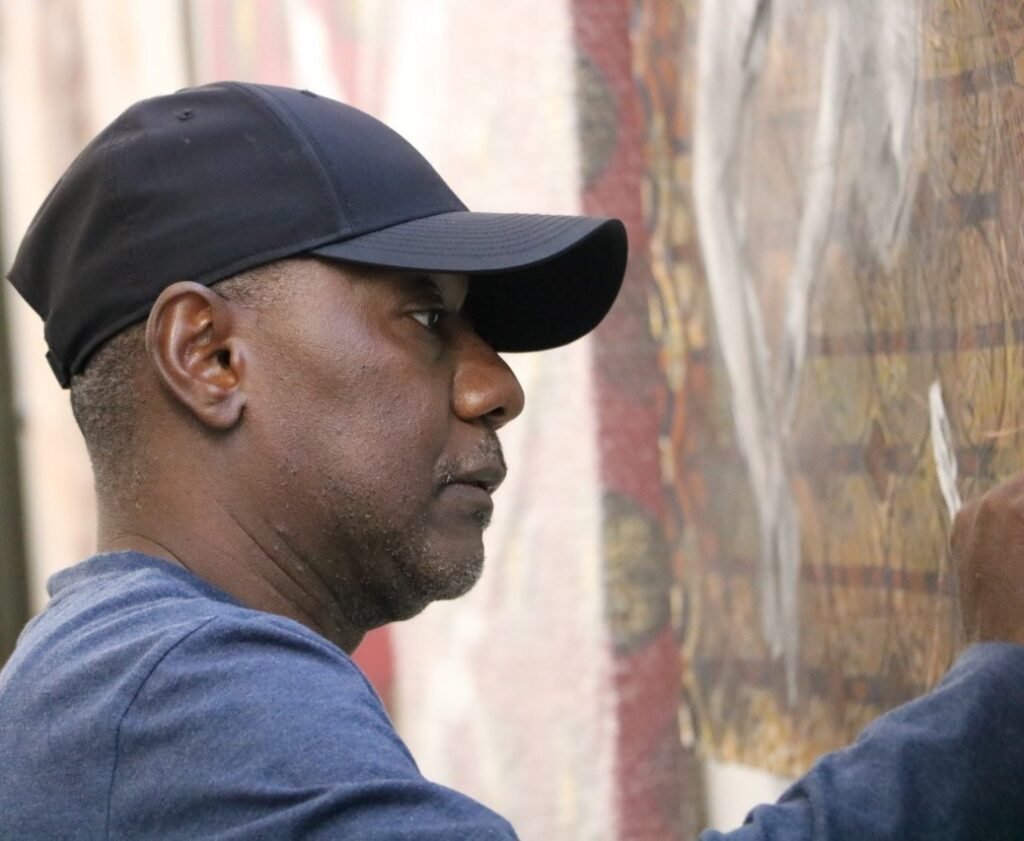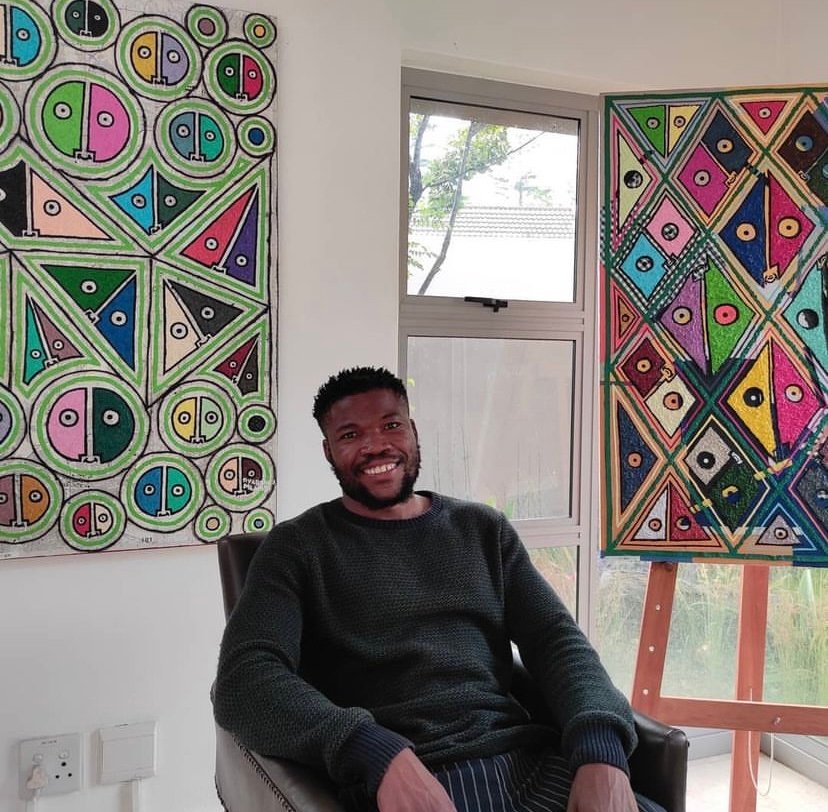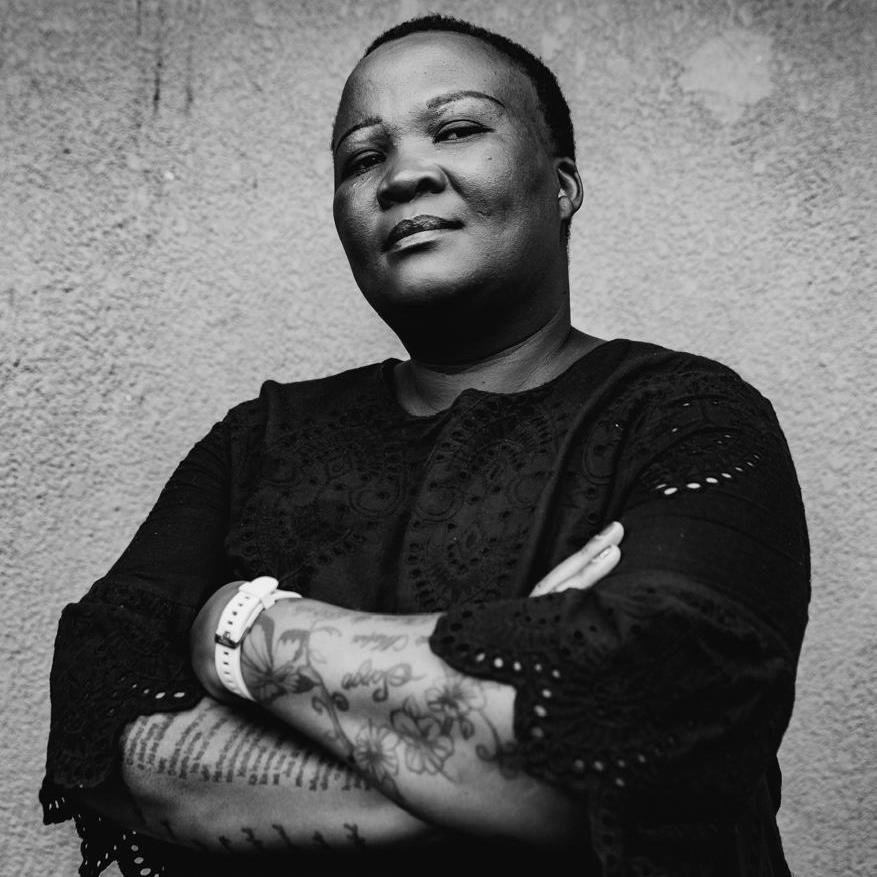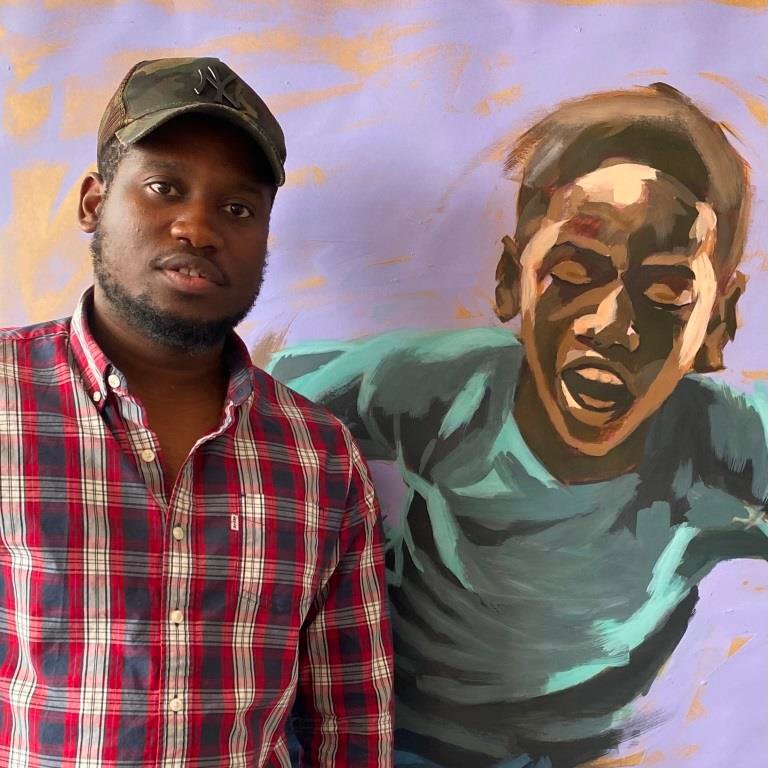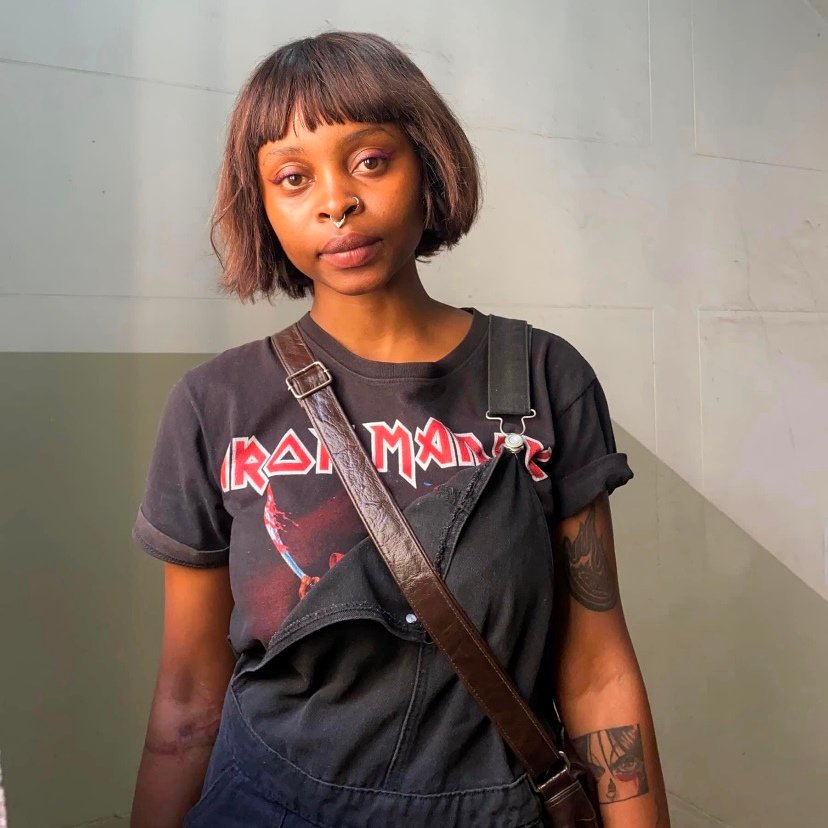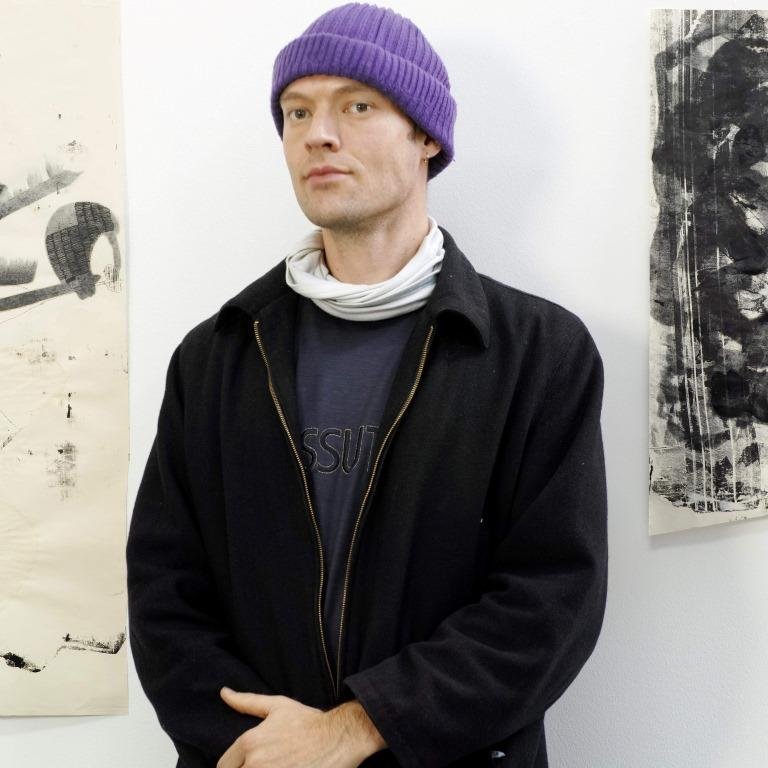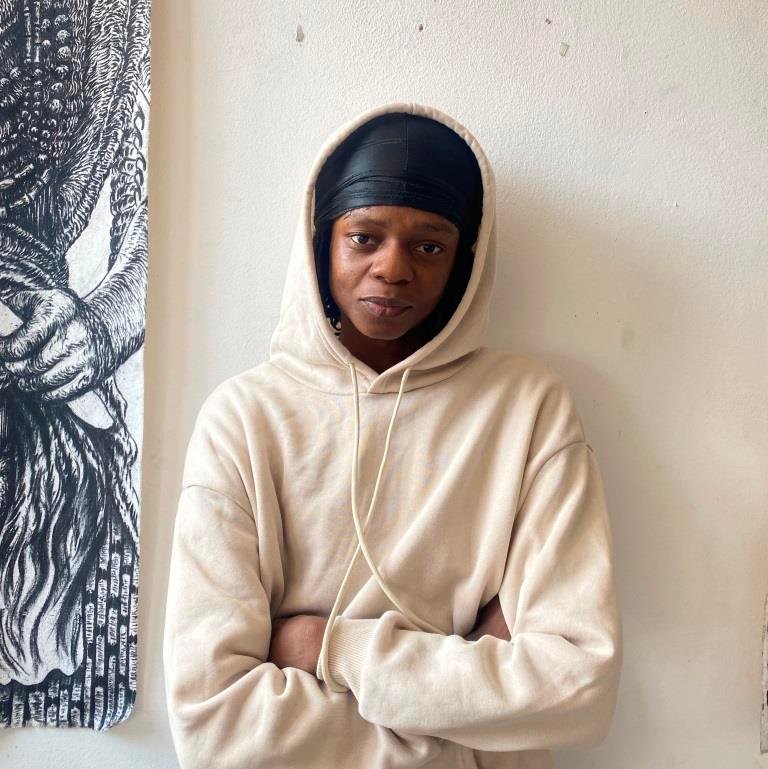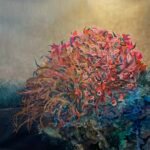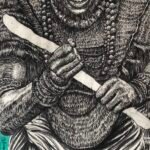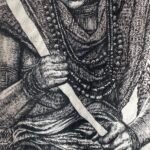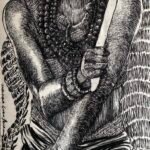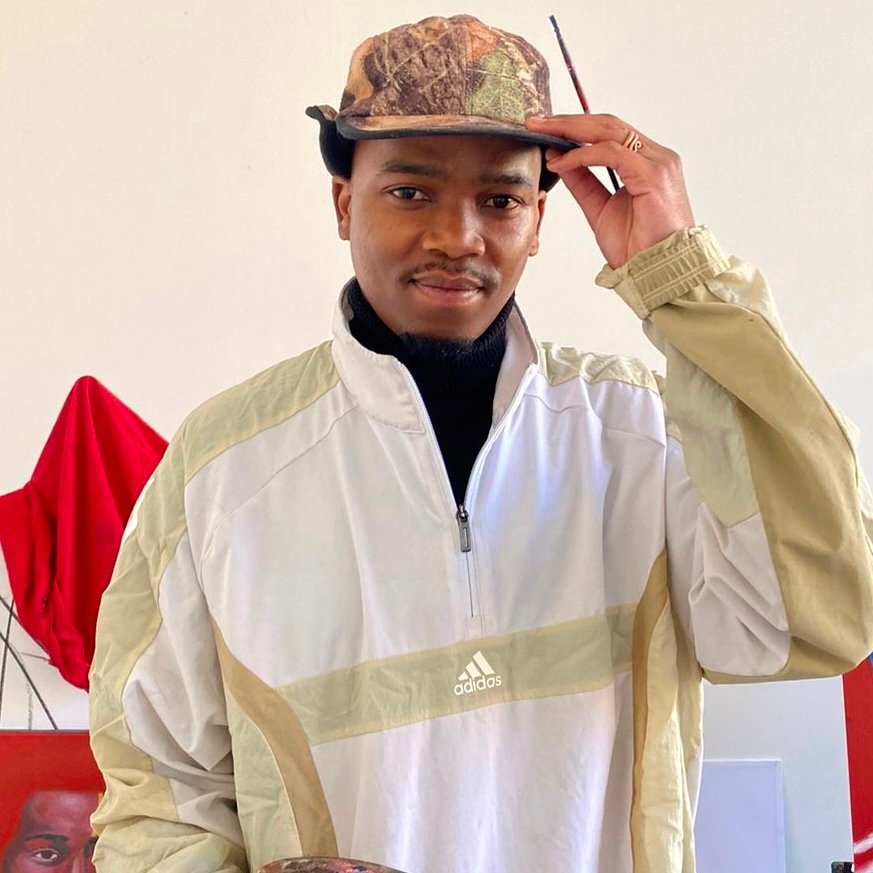
Kaya Mazule
Introduction
Kaya Mazule, an emerging artist from Nqgeleni village in Mthatha, Eastern Cape, has carved a unique path within the contemporary African art scene. His journey, rich in cultural history and personal exploration, has been shaped by early exposure to art, the influence of supportive educators, and an unyielding desire to reflect his heritage through various artistic mediums. As he navigates between traditional and modern approaches to art, Kaya remains firmly committed to telling stories of his Xhosa roots while exploring the broader complexities of African identity. His art is a testament to the power of expression, bridging the gap between tradition and contemporary culture, and his future, as a multidisciplinary artist, looks promising and full of potential.
Early Life and Artistic Beginnings
Born in the tranquil yet rich cultural environment of Nqgeleni, Mthatha, Kaya’s journey into the world of art began in primary school. Like many creative individuals, his talents were first recognized by the educators around him. The turning point came when Kaya’s teachers saw his potential and offered him a chance to create class posters. Recognizing his interest in drawing, they provided him with the necessary supplies and encouragement to explore his budding passion. These early experiences were formative in his development, allowing Kaya to tap into his natural creativity and express himself visually.
It was during these formative years that Kaya discovered his love for art. While his teachers played an essential role in introducing him to the world of creativity, Kaya’s fascination with the visual arts grew organically. He was encouraged to experiment and push the boundaries of his imagination, something that would become a hallmark of his artistic approach later on. His passion for art would become a lifelong pursuit, one that would continue to evolve as he matured and developed his artistic voice.
Education and a Return to Art
Though Kaya’s early exposure to art was invaluable, his educational path initially took him away from the world of creativity. After completing his primary schooling, Kaya pursued studies in mathematics and statistics, a decision that was likely influenced by societal pressures to seek more stable, pragmatic career paths. However, despite his academic focus on the sciences, Kaya’s love for art never waned. Art remained in the background of his life, a constant companion in his creative journey.
After completing his studies, Kaya made a conscious decision to return to his passion for art. He realized that his true calling lay in expressing himself through visual mediums, and he sought to reconnect with his artistic roots. This return to art allowed him to cultivate a deeper understanding of his craft, ultimately leading him to explore a wide range of artistic styles and techniques. Kaya’s versatility as an artist became evident as he began experimenting with different materials and subjects, from painting to fabric design.
Influences: Cultural Heritage and Global Inspirations
Kaya’s artistic practice is profoundly influenced by his cultural heritage. Growing up in the Eastern Cape, in a village steeped in traditions, Kaya was exposed to a way of life that was deeply connected to the land, customs, and spiritual beliefs. Though the rituals, traditions, and practices of his community were not always immediately understandable to him, they formed an essential part of his identity. As he matured, these aspects of his heritage began to resonate with him more deeply, inspiring much of his current work.
One of Kaya’s key thematic focuses is the exploration of Xhosa culture, particularly the significance of headwraps and traditional attire. These items of clothing are more than just cultural markers—they serve as symbols of identity, status, and ritual within the Xhosa community. Through his art, Kaya delves into the various meanings and occasions associated with these garments. He seeks to reflect the complexities of these cultural symbols, conveying how they relate to the wider African diaspora and their continued relevance in the modern world.
In addition to his direct cultural influences, Kaya’s artistic practice is informed by a variety of global sources. Among his favourite artists are Loyiso Mkhize, a multidisciplinary artist whose work spans painting, fashion, and graphic design, and Baba Tjeko, known for his diverse approach to art. Kaya is drawn to these artists’ ability to work across different disciplines, and he too envisions a future where he can create in various mediums, from fashion design to comic books, printmaking, and illustration. He appreciates how these artists blend traditional African culture with contemporary global aesthetics, and he strives to do the same in his own work.
Despite his diverse influences, Kaya’s art is largely shaped by his personal experiences growing up in the Eastern Cape. Village life, with its complexities, rituals, and profound sense of community, remains a core element of his artistic exploration. Kaya contrasts village life with urban experiences, often reflecting on the differences and similarities he perceives between these two ways of life. This exploration helps him grapple with issues of identity, modernity, and tradition, which are central themes in his work.
Thematic Focus: Superstitions, Traditions, and Culture
Kaya’s artwork is deeply thematic, focusing on issues that range from superstitions and cultural rituals to the complexity of African identity. His fascination with African cultural practices often leads him to explore the symbolism behind certain traditions and beliefs. The Xhosa headwrap, for example, is a recurring motif in Kaya’s work. These headwraps are worn on different occasions and for various reasons, often reflecting a person’s status, spiritual beliefs, or emotional state. For Kaya, these garments represent much more than just fashion; they embody layers of meaning and are deeply tied to identity, culture, and heritage.
In his art, Kaya seeks to decode these symbols and express their deeper meanings, highlighting the tension between traditional beliefs and modern interpretations. This is a theme that resonates across Africa, where many young people are caught between honouring ancient practices and navigating the realities of a rapidly changing world. Kaya’s work acts as a bridge between these two worlds, inviting viewers to reconsider and appreciate the richness of African culture.
Kaya’s use of traditional materials such as oil and acrylic on canvas reflects his desire to work within established artistic traditions. Oils allow him to plan and manipulate his work with great precision, offering flexibility and control. On the other hand, acrylics allow for a more spontaneous approach, enabling Kaya to execute ideas quickly and with a sense of urgency. This duality in his materials reflects his ability to work both intentionally and fluidly, a skill that will serve him well as he expands into other mediums.
Expanding Horizons: Fashion, Sculpture, and Multidisciplinary Art
While Kaya’s current work focuses on painting, he has expressed a keen interest in exploring other artistic disciplines. He dreams of working in fashion design, fabric design, and even sculpture, following in the footsteps of artists like Loyiso Mkhize and Baba Tjeko, who work across multiple mediums to create a more holistic and diverse body of work. Kaya believes that the future of art lies in multidisciplinary approaches, and he is eager to experiment with different materials, techniques, and platforms.
Fashion holds a special appeal for Kaya. As someone deeply attuned to the cultural significance of clothing and accessories, he is excited by the prospect of merging art and fashion to create pieces that speak to both aesthetic beauty and cultural heritage. By working in fabric design, he hopes to produce garments that tell stories, just as his paintings do. The potential for cross-disciplinary collaboration in fashion, illustration, and art excites him, and he envisions a future where his work spans many different areas, including printmaking and comic books.
The Future: A Vision of Artistic Growth
Looking ahead, Kaya is optimistic about his future as an artist. He sees himself not only as a painter but as an author, a fashion designer, and a creator of multimedia works. His ambition to work across disciplines reflects his belief that art should not be confined to a single medium or method of expression. He is passionate about sharing African culture with the world and believes that his work has the potential to open new conversations about identity, tradition, and the African experience.
Kaya’s determination to continue working in traditional mediums, while also exploring new possibilities in fashion and sculpture, positions him as a dynamic and versatile artist. His commitment to showcasing African culture through his art ensures that his work will remain relevant, impactful, and connected to his roots. With his rich cultural heritage as his foundation and his boundless curiosity about the world as his guide, Kaya Mazule is well on his way to becoming one of the most exciting and multifaceted artists of his generation.
Conclusion
Kaya Mazule’s journey as an artist is one of growth, exploration, and cultural affirmation. From his early days in Nqgeleni village to his current work, Kaya’s art is a testament to the power of education, heritage, and personal expression. His work, rooted in the traditions of the Eastern Cape, speaks to the complexity of African identity, particularly through the lens of Xhosa culture. As he continues to expand his creative boundaries and explore new artistic mediums, Kaya is poised to make a lasting impact on the world of contemporary African art. His future looks bright, and his ability to blend tradition with modernity will undoubtedly define his place in the evolving art landscape.
On Auction
-
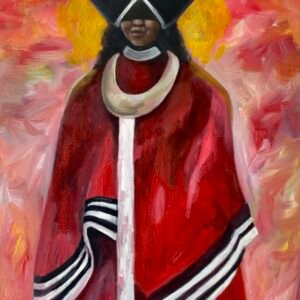 The OracleAuction Expired
The OracleAuction Expired -
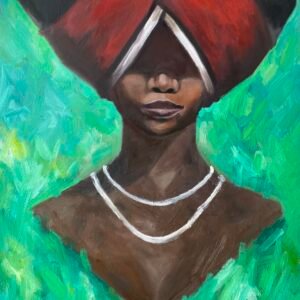 NobomvuAuction Expired
NobomvuAuction Expired -
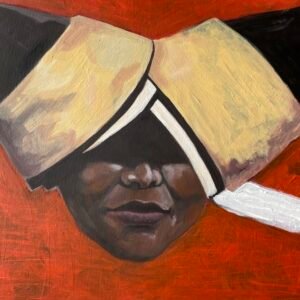 KhetshemiyaAuction Expired
KhetshemiyaAuction Expired

